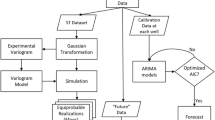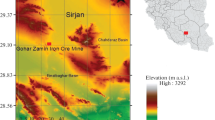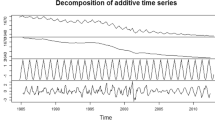Abstract
In arid and semi-arid environments, groundwater plays a significant role in the ecosystem. In the last decades, groundwater levels have decreased due to the increasing demand for water, weak irrigation management and soil damage. For the effective management of groundwater, it is important to model and predict fluctuations in groundwater levels. In this study, several time series models were applied to predict groundwater level forecasting in Kashan plain, Isfahan province, Iran. At first, to reduce the calculation volume, the water table depths in 36 piezometric wells were clustered based on the Vard algorithm. Consequently, we categorized the 36 wells into five clusters. For each cluster, five time series models of auto-regressive (AR), moving-average (MA), auto-regressive moving-average (ARMA), auto-regressive integrated moving-average (ARIMA) and seasonal auto-regressive integrated moving-average (SARIMA) were applied. The results showed that the AR model with a two-times lag (AR(2)), shows the best forecasting of groundwater level for 60 months ahead of the five clusters, with a high accuracy of R 2 (0.89, 0.89, 0.95, 0.95 and 0.75 in clusters 1 to 5, respectively). According to the results, the average groundwater level fluctuation in 2010 and 2016 was 74.58 and 80.71 m, respectively. With these conditions, the groundwater depletion rate would be 1.02 m per year in 2016. We combined several time series models for a better performance of prediction of groundwater level. We can conclude that combining time series models have an advantage in terms of groundwater level forecasting.











Similar content being viewed by others
References
Adamowski J, Chan HF (2011) A wavelet neural network conjunction model for groundwater level forecasting. J Hydrol 407(1–4):28–40. doi:10.1016/j.jhydrol.2011.06.013
Akkaya Aslan ST, Gundogdu KS (2007) Mapping multi-year groundwater depth patterns from time-series analyses of seasonally lowest depth-to-groundwater maps in irrigation areas. Pol J Environ Stud 16(2):183–190. doi:10.1002/hyp.6643
Alpaydin E (2009) Introduction to machine learning. The MIT Press, Cambridge
Arnell NW, Liu C (2001) Hydrology and water resources, in climate change 2001: impacts, adaptation, and vulnerability: contribution of working group II to the third assessment report of the intergovernmental panel on climate change. Cambridge University Press, New York
Barnett TP, Adam JC, Lettenmaier DP (2005) Potential impacts of a warming climate on water availability in snow-dominated regions. Nature 438(7066):303–309. doi:10.1038/nature04141
Bender S, Brand R, Bacher J (2001) Re-identifying register data by survey data: an empirical study. Stat J U N Econ Comm Eur 18:373–381
Bower D, Hannah DM, McGregor GR (2004) Techniques for assessing the climatic sensitivity of river flow regimes. Hydrol Process 18:2515–2543. doi:10.1002/hyp.1479
Box GEP, Jenkins GM, Reinsel GC (1994) Time series analysis: forecasting and control. Prentice Hall, Englewood Cliffs
Bras RL, Rodriguez-Iturbe I (1985) Random functions and hydrology. Addison-Wesley, Reading
Brockwell PJ, Davis RA (2010) Introduction to time series and forecasting. Springer, New York
Emamgholizadeh S, Moslemi K, Karami G (2014) Prediction the groundwater level of bastam plain (Iran) by artificial neural network (ANN) and adaptive neuro-fuzzy inference system (ANFIS). Water Resour Manag. doi:10.1007/s11269-014-0810-0
Erdem E, Shi J (2011) ARMA based approaches for forecasting the tuple of wind speed and direction. Appl Energy 84(2):1405–1414. doi:10.1016/j.apenergy.2010.10.031
Faruk D (2010) A hybrid neural network and ARIMA model for water quality time series prediction. Eng Appl Artif Intell 23(4):586–594. doi:10.1016/j.engappai.2009.09.015
Ghazavi R, Thomas Z, Hamon Y, Marie JC, Corson M, Merot P (2008) Hedgerow impacts on soil-water transfer due to rainfall interception and root-water uptake. Hydrol Process 22(24):4723–4735. doi:10.1002/hyp.7081
Ghazavi R, Vali AB, Eslamian S (2012) Impact of flood spreading on groundwater level variation and groundwater quality in an arid environment. Water Resour Manag 26(6):1651–1663. doi:10.1007/s11269-012-9977-4
Hannan EJ (1971) Multiple time series. Wiley, New York
He Z, Zhang Y, Guo Q, Zhao X (2014) Comparative study of artificial neural networks and wavelet artificial neural networks for groundwater depth data forecasting with various curve fractal dimensions. Water Resour Manag. doi:10.1007/s11269-014-0802-0
Hipel KW, Mcleod AI (1994) Time series modeling of water resources and environmental systems. Elsevier Science, Amesterdam
Javidi Sabbaghian R, Sharifi MB (2009) Random modeling application in river flow simulation and estimation of mean annual river discharge by time series analysis. International Conference on Water Resources (ICWR). Shahrood, Iran, August 15–17, 2009
Jolly ID, McEwan KL, Holland KL (2008) A review of groundwater–surface water interactions in arid/semi-arid wetlands and the consequences of salinity for wetland ecology. Ecohydrology 1(1):43–58. doi:10.1002/eco.6
Kim SJ, Hyun Y, Lee KK (2005) Time series modeling for evaluation of groundwater discharge rates into an urban subway system. Geosci J 9(1):15–22. doi:10.1007/BF02910550
Kumar Adhikary S, Md MR, Das Gupta A (2012) A stochastic modeling technique for predicting groundwater table fluctuations with time series analysis. Int J Appl Sci Eng Res 1(2):238–249. doi:10.6088/ijaser.0020101024
Lee JK, Lee KK (2000) Use of hydrologic time series data for identification recharge mechanism in a fractured bedrock aquifer system. J Hydrol 229(3–4):190–201. doi:10.1016/S0022-1694(00)00158-X
Lettenmaier DP, Wood AW, Palmer RN, Wood EF, Stakhiv EZ (1999) Water resources implications of global warming: A U.S. regional perspective. Clim Chang 43(3):537–579. doi:10.1023/A:1005448007910
Li F, Feng P, Zhang W, Zhang T (2013) An integrated groundwater management mode based on control indexes of groundwater quantity and level. Water Resour Manag 27(9):3273–3292. doi:10.1007/s11269-013-0346-8
Li F, Qiao J, Zhao Y, Zhang W (2014) Risk assessment of groundwater and its application. Part II: using a groundwater risk maps to determine control levels of the groundwater. Water Resour Manag 28(13):4875–4893. doi:10.1007/s11269-014-0784-y
Lin GF, Lee FC (1992) An aggregation– disaggregation approach for hydrologic time series modelling. J Hydrol 138(3–4):543–557. doi:10.1016/0022-1694(92)90136-J
Mondal MS, Wasimi SA (2007) Choice of model type in stochastic river hydrology. the 1th International Conference on Water & Flood Management (ICWFM), Dhaka, Bangladesh, March 12–14,2007
Pérez-Martín MA, Estrela T, Andreu J, Ferrer J (2014) Modeling water resources and river-aquifer interaction in the Júcar River Basin, Spain. Water Resour Manag 28(12):4337–4358. doi:10.1007/s11269-014-0755-3
Poormohammadi S, Malekinezhad H, Poorshareyati R (2013) Comparison of ANN and time series appropriately in prediction of ground water table (Case Study: Bakhtegan basin). Water Soil Conserv 20(4):251–262
Saeidian Y, Ebadi H (2004) Determine the time series of data flow (case study: Vanyar station in the river basin Ajichai). 2th Students Conference on Soil and Water Resources, Shiraz, Iran, May 12–13,2004
Shirmohammadi B, Vafakhah M, Moosavi V, Moghaddamnia A (2013) Application of several data-driven techniques for predicting groundwater level. Water Resour Manag 27:419–432. doi:10.1007/s11269-012-0194-y
Sophocleous M (2004) Climate change: why should water professionals care? Ground Water 42(5):637. doi:10.1111/j.1745-6584.2004.tb02715.x
Tankersly CD, GrahamWD HK (1993) Comparision of univariate and transfer function noise models of groundwater fluctuations. Water Resour Res 29(10):3517–3533. doi:10.1029/93WR01527
Todd DK, Mays LW (2005) Groundwater hydrology. Wiley, Hoboken
Tseng FM, HCh Y, Tzeng GH (2002) Combining neural network model with seasonal time series ARIMA model. Technol Forecast Soc Chang 69(1):71–87. doi:10.1016/S0040-1625(00)00113-X
Von Asmuth JR, Maas K, Knotters M, Bierkens MFP, Bakker M, Olsthoorn TN, GijsbertCirkel D, Leunk I, Schaars F, Von Asmuth DC (2012) Software for hydrogeologic time series analysis, interfacing data with physical insight. Environ Model Softw 38:178–190. doi:10.1016/j.envsoft.2012.06.003
Wu TN, Lee JY, Huang ChH (2010) Application of time series analysis on temporal variation of fluoride in groundwater around Southern Taiwan Science Park. 7th International conference on fuzzy systems and knowledge discovery (FSKD), Yantai, China, August 10–12, 2010
Zare Chahuki MA (2010) Data analysis in natural resources research using SPSS software. Academic, Tehran
Author information
Authors and Affiliations
Corresponding author
Rights and permissions
About this article
Cite this article
Mirzavand, M., Ghazavi, R. A Stochastic Modelling Technique for Groundwater Level Forecasting in an Arid Environment Using Time Series Methods. Water Resour Manage 29, 1315–1328 (2015). https://doi.org/10.1007/s11269-014-0875-9
Received:
Accepted:
Published:
Issue Date:
DOI: https://doi.org/10.1007/s11269-014-0875-9




